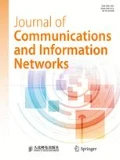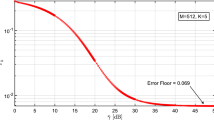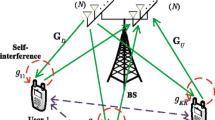Abstract
When designing an energy efficient massive multiple-input multiple-output (MIMO) system where each receiver antenna is equipped with a low-resolution analog-to-digital converter (ADC), the number of base station (BS) antennas and quantization bits are generally two mutually conflicting system parameters. In this paper, we investigate the joint optimization of the number of BS antennas and ADC resolution in quantized massive MIMO systems, assuming imperfect channel state information (CSI). A tractable approximate expression for the uplink sum spectral efficiency (SE) using maximal ratio combining (MRC) receivers is derived, based on which the pilot length which maximizes the sum SE is put forward. Considering the effect of ADCs, a realistic model of total power consumption is given subsequently. Capitalizing on it, we formulate the optimization problem of selecting the number of BS antennas and ADC resolution to maximize the sum SE under a total power consumption constraint. Our results show that more pilot symbols should be assigned for massive MIMO systems with low-resolution ADCs, especially for the receivers with one-bit quantizers. Moreover, the results show the trade-off between the number of BS antennas and quantization bits. Numerical results suggest that there exists an optimal ADC resolution in massive MIMO systems, while lower quantization bits may cause a substantial degradation of the SE performance and higher one will consume more power.
Similar content being viewed by others
References
C. V. N. Index, Global mobile data traffic forecast update 2014-2019 white paper [J]. 2015
G. Pan, H. Lei, Y. Deng, et al. On secrecy performance of MISO SWIPT systems with TAS and imperfect CSI [J]. IEEE Transactions on Communications, 2016, 64(9): 3831–3843
W. Tan, M. Matthaiou, S. Jin, et al. Spectral efficiency of DFT based processing hybrid architectures in massive MIMO [J]. IEEE Wireless Communications Letters, 2017, 6(5): 586–589
J. Yuan, S. Jin, W. Xu, et al. User-centric networking for dense CRANS: High-SNR capacity analysis and antenna selection [J]. IEEE Transactions on Communications, 2017, 65(5): 5067–5080
M. Zhang, W. Tan, J. Gao, et al. Spectral efficiency and power allocation for mixed-ADC massive MIMO system [J]. China Communications, 2018, 15(3): 112–127
G. Auer, O. Blume, V. Giannini. Energy efficiency analysis of the reference systems, areas of improvements and target breakdown [J]. INFSO-ICT-247733 EARTH, ver. 2.0, 2012
W. Q. Tan, X. Li, D. Q. Xie. On the performance of three dimensional antenna arrays in millimeter wave propagation environments [J]. IET Communications, 2018
W. Tan, S. Jin, C. K. Wen, et al. Spectral efficiency of multi-user millimeter wave systems under single path with uniform rectangular arrays [J]. Eurasip Journal on Wireless Communications & Networking, 2017, 181(10): 1–13
Y. Chen, S. Zhang, S. Xu, et al. Fundamental trade-offs on green wireless networks [J]. IEEE Communications Magazine, 2011, 49(6): 30–37
D. Feng, C. Jiang, G. Lim, et al. A survey of energy-efficient wireless communications [J]. IEEE Communications Surveys & Tutorials, 2013, 15 (1): 167–178
O. Blume, A. Ambrosy, M. Wilhelm, et al. Energy efficiency of LTE networks under traffic loads of 2020 [C]//Proceedings of the 10th International Symposium on Wireless Communication Systems (ISWCS), Ilmenau, 2013: 1–5
W. Tan, J. Xia, D. Xie, et al. Spectral and energy efficiency of massive MIMO for hybrid architectures based on phase shifters [J]. IEEE Access, 2018, 6: 11751–11759
T. L. Marzetta. Noncooperative cellular wireless with unlimited numbers of base station antennas [J]. IEEE Transactions on Wireless Communications, 2010, 9(11): 3590–3600
H. Q. Ngo, E. G. Larsson, T. L. Marzetta. Energy and spectral efficiency of very large multiuser MIMO systems [J]. IEEE Transactions on Communications, 2013, 61(4): 1436–1449
M. H. Du, G. Y. Luo, F. S. Zhou, et al. Joint source-channel coding for band-limited backhauls in coordinated multi-point systems [J]. IET Communications, 2016, 10(13): 1562–1570
D. D. Nguyen, Y. Liu, Q. Chen. On the energy efficient multi-pair twoway massive MIMO af relaying with imperfect CSI and optimal power allocation [J]. IEEE Access, 2018, 6: 2589–2603
A. Adhikary, J. Nam, J. Y. Ahn, et al. Joint spatial division and multiplexing-the large-scale array regime [J]. IEEE Transactions on Information Theory, 2013, 59(10): 6441–6463
C. Sun, X. Gao, S. Jin, et al. Beam division multiple access transmission for massive MIMO communications [J]. IEEE Transactions on Communications, 2015, 63(6): 2170–2184
H. X. Xie, F. F. Gao, S. Zhang, et al. A unified transmission strategy for TDD/FDD massive MIMO systems with spatial basis expansion model [J]. IEEE Transactions on Vehicular Technology, 2017, 66(4): 3170–3184
J. Mo, R.W. Heath. Capacity analysis of one-bit quantized MIMO systems with transmitter channel state information [J]. IEEE Transactions on Signal Processing, 2015, 63(20): 5498–5512
O. Orhan, E. Erkip, S. Rangan. Low power analog-to-digital conversion in millimeter wave systems: Impact of resolution and bandwidth on performance [C]//Information Theory & Applications Workshop, San Diego, 2015: 191–198
L. Fan, S. Jin, C. K. Wen, et al. Uplink achievable rate for massive MIMO systems with low-resolution ADC [J]. IEEE Communications Letters, 2015, 19(12): 2186–2189
D. Qiao, W. Tan, Y. Zhao, et al. Spectral efficiency for massive MIMO zero-forcing receiver with low-resolution ADC [C]//The 8th International Conference onWireless Communications and Signal Processing, Yangzhou, 2016: 1–6
J. Zhang, L. Dai, S. Sun, et al. On the spectral efficiency of massive MIMO systems with low-resolution ADCs [J]. IEEE Communications Letters, 2016, 20(5): 842–845
C. Mollen, J. Choi, E. G. Larsson, et al. Performance of the wideband massive uplink MIMO with one-bit ADCs [J]. arXiv:1602.07364, 2016
O. Orhan, E. Erkip, S. Rangan. Low power analog-to-digital conversion in millimeter wave systems: Impact of resolution and bandwidth on performance [C]//Proceedings of Information Theory & Its Applications Workshop, San Diego, 2015: 191–198
H. Yang, T. L. Marzetta. Total energy efficiency of cellular large scale antenna system multiple access mobile networks [C]//IEEE Online Conference on Green Communications (GreenCom), Piscataway, 2013: 27–32
A. Mezghani, N. Damak, J. A. Nossek. Circuit aware design of power-efficient short range communication systems [C]//The 7th International Symposium on Wireless Communication Systems (ISWCS), York, 2010: 869–873
S. Tombaz, A. Vastberg, J. Zander. Energy and cost efficient ultra-high capacity wireless access [J]. IEEE Communications Magazine. 2011, 18(5): 18–24
E. Björnson, L. Sanguinetti, J. Hoydis, et al. Optimal design of energyefficient multi-user MIMO systems: Is massive MIMO the answer? [J]. IEEE Transactions on Wireless Communications, 2015, 14(6): 3059–3075
D. Verenzuela, E. Björnson, M. Matthaiou. Hardware design and optimal ADC resolution for uplink massive MIMO systems [C]//IEEE Sensor Array and Multichannel Signal Processing Workshop (SAM), Rio de Janerio, 2016: 1–5
Q. Zhang, S. Jin, K. K. Wong, et al. Power scaling of uplink massive MIMO systems with arbitrary-rank channel means [J]. IEEE Journal of Selected Topics in Signal Processing, 2014, 8(5): 966–981
Y. Yuan, R. Zhao, H. Lin, et al. Secrecy performance analysis of cognitive decode-and-forward relay networks in Nakagami-m fading channels [J]. IEEE Transactions on Communications, 2017, 65(2): 549–563
L. Fan, X. Lei, N. Yang, et al. Secure multiple amplify-and-forward relaying with cochannel interference [J]. IEEE Journal of Selected Topics in Signal Processing, 2016, 10(8): 1494–1505
X. Lai, W. Zou, D. Xie, et al. DF relaying networks with randomly distributed interferers [J]. IEEE Access, 2017, 5: 18909–18917
H. Q. Ngo, M. Matthaiou, E. G. Larsson. Massive MIMO with optimal power and training duration allocation [J]. IEEE Wireless Communications Letters, 2014, 3(6): 605–608
T. L. Marzetta. How much training is required for multiuser MIMO [C]//The 40th Asilomar Conference on Signals, Systems and Computers, Pacific Grove, 2006: 359–363
B. Hassibi, B. M. Hochwald. How much training is needed in multipleantenna wireless links [J]. IEEE Transactions on Information Theory, 2003, 49(4): 951–963
S. Verd. Spectral efficiency in the wideband regime [J]. IEEE Transactions on Information Theory, 2002, 48(6): 1319–1343
A. Mezghani, J. A. Nossek. Modeling and minimization of transceiver power consumption in wireless networks [C]//International ITGWorkshop on Smart Antennas (WSA), Aachen, 2011: 1–8
A. Mezghani, N. Damak, J. A. Nossek. Circuit aware design of power-efficient short range communication systems [C]//7th Interna tional Symposium on Wireless Communication Systems (ISWCS), York, 2010: 869–873
Murmann B. Limits on ADC power dissipation [M]. Analog Circuit Design. Dordrecht: Springer, 2006: 351–367.
Author information
Authors and Affiliations
Corresponding author
Additional information
This work is supported in part by the National Science Foundation (NSFC) for Distinguished Young Scholars of China (No. 61625106), the National Natural Science Foundation of China (No. 61531011) and the Project of Educational Commission of Guangdong Province of China (No. 2017KQNCX155). The associate editor coordinating the review of this paper and approving it for publication was W. Zhang.
Dan Qiao was born in Jiangsu, China, in 1991. She received her B.S. degree and the M.S. degree from the School of Information Science and Engineering, Southeast University, Nanjing, China in 2014 and 2017 respectively. Her main research interests include massive MIMO systems, and low resolution ADCs.
Xi Yang received her B.S. degree and the M.S. degree from Southeast University, Nanjing, China in 2013 and 2016 respectively. She is currently working toward her Ph.D. degree with the School of Information Science and Engineering, Southeast University. Her main research interests include massive MIMO system prototyping, beam training and channel estimation in millimeter wave, and millimeter wave system prototyping.
Weiqiang Tan received his Ph.D. degree from the National Mobile Communications Research Laboratory, Southeast University, Nanjing, China, in 2017. He received his M.S. degree from Chengdu University of Information Technology, China, in 2013. From 2016 to 2017, he was a visiting Ph.D student with the School of Electronics, Electrical Engineering and Computer Science, Queen’s University Belfast, United Kingdom. He is currently with the School of Computer Science and Educational Software, Guangzhou University, China. His research interests include massive MIMO system and Millimeter wave wireless communication.
Chaokai Wen (S’00-M’04) received his Ph.D. degree from the Institute of Communications Engineering, National Tsing Hua University, Taiwan, China, in 2004. He was with Industrial Technology Research Institute, Hsinchu, Taiwan, China and MediaTek Inc., Hsinchu, Taiwan, China, from 2004 to 2009. He is currently an Associate Professor of the Institute of Communications Engineering, National Sun Yat-sen University, Kaohsiung, Taiwan. His research interests center around the optimization in wireless multimedia networks.
Shi Jin (S’06-M’07) [corresponding author] received his B.S. degree in communications engineering from Guilin University of Electronic Technology, Guilin, China, in 1996; his M.S. degree from Nanjing University of Posts and Telecommunications, Nanjing, China, in 2003; and his Ph.D. degree in communications and information systems from Southeast University, Nanjing, in 2007. From June 2007 to October 2009, he was a Research Fellow with the Adastral Park Research Campus, University College London, London, U.K. He is currently with the faculty of the National Mobile Communications Research Laboratory, Southeast University. His research interests include space-time wireless communications, random matrix theory, and information theory. Dr. Jin serves as an Associate Editor for the IEEE Transactions onWireless Communications, the IEEE Communications Letters, and IET Communications. He and his coauthors received the 2010 Young Author Best Paper Award by the IEEE Signal Processing Society and the 2011 IEEE Communications Society Stephen O. Rice Prize Paper Award in the field of communication theory.
Rights and permissions
About this article
Cite this article
Qiao, D., Yang, X., Tan, W. et al. Low-Cost Massive MIMO: Pilot Length and ADC Resolution. J. Commun. Inf. Netw. 3, 23–36 (2018). https://doi.org/10.1007/s41650-018-0020-7
Received:
Accepted:
Published:
Issue Date:
DOI: https://doi.org/10.1007/s41650-018-0020-7




